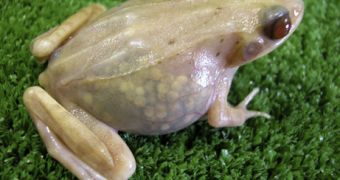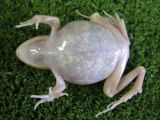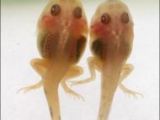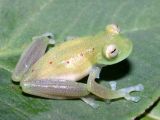This newly engineered amphibian could save thousands of frogs from massacre worldwide, no matter if for dissections in biology classes or medical research. A Japanese team succeeded in producing see-through frogs, so you can see their organs, blood vessels and eggs without the need of removing skin and muscles.
"You can see through the skin how organs grow, how cancer starts and develops," said the lead researcher Masayuki Sumida, professor at the Institute for Amphibian Biology of Hiroshima University.
"You can watch organs of the same frog over its entire life as you don't have to dissect it. The researcher can also observe how toxins affect bones, livers and other organs at lower costs," Sumida told AFP.
Animal rights activists are already increasingly making pressures regarding humane alternatives for dissections, like computer simulations.
In nature, there are also some small see-through fish, like glassy fish of the family Ambassidae or the glass catfish of the Kryptopterus genus (both groups from southern Asia), and even semitransparent frogs, the glass frogs of the Cemtrolenidae family, found in tropical America and closely related to tree frogs.
The new transparent frog was obtained from Japanese brown frogs (Rana japonica), whose backs are normally ochre or brown. Two types of recessive genes produce the lack of coloration.
Sumida's team bred two frogs carrying recessive genes through artificial insemination and the first generation looked normal as the colorless genes were masked by normal color genes. But when the hybrids where interbred, they produced frogs with transparent skin from the tadpole stage, in a ratio of 1:16 (from 16 eggs, one produced a transparent frog).
"You can see dramatic changes of organs when tadpoles mutate into frogs. Such frogs could theoretically exist in the wild but it is "virtually impossible" they would naturally inherit so many recessive genes," Sumida said.
The transparent frogs are fertile, producing only transparent frogs when interbred, but the offspring of their offspring die soon after hatching.
"As they have two sets of recessive genes, something wrong must kick in and kill them," Sumida said.
"Researchers could also inject into the transparent frogs an illuminating protein attached to a gene, which would light up the gene once it manifests -- for example, showing at what stage cancer starts. It would be unrealistic to apply the same method to mammals such as mice as their skin structure is different." said Sumida.
The new frog is the first four-legged transparent animal created by scientists.

 14 DAY TRIAL //
14 DAY TRIAL // 


